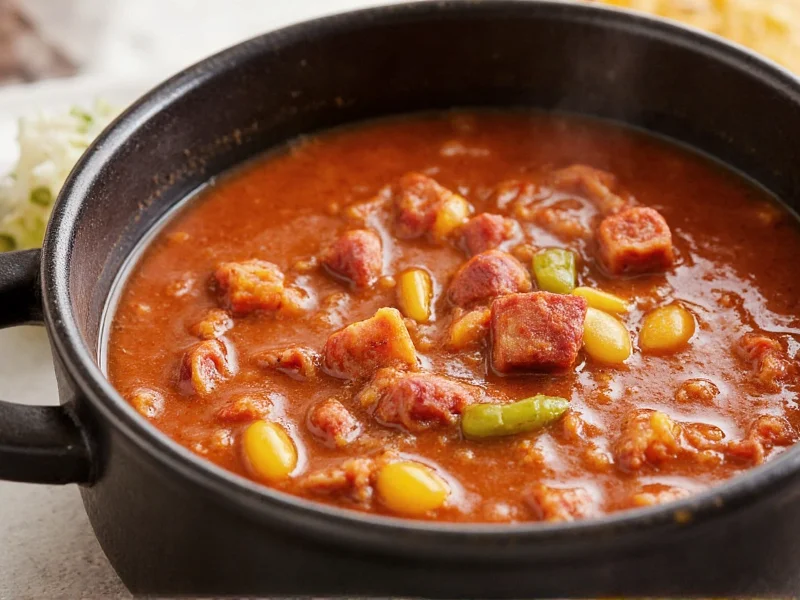While many associate pastrami exclusively with sandwiches, its journey into soup form represents a practical and delicious adaptation of traditional Jewish cooking. This transformation occurred as immigrant communities in early 20th century America sought ways to utilize every part of the animal, minimizing waste while creating nourishing meals. The resulting authentic New York pastrami soup became a staple in Jewish delis and home kitchens alike.
The Cultural Roots of Pastrami Soup
Understanding pastrami soup history and origins requires examining both the meat's evolution and Jewish culinary traditions. Pastrami itself descended from Romanian pastramă, a preservation method for goose or mutton. Jewish immigrants adapted this technique using more readily available beef brisket in America, seasoning it with garlic, coriander, black pepper, and paprika before smoking.
When preparing traditional Jewish pastrami soup, cooks discovered that simmering leftover pastrami created an exceptionally flavorful broth. This resourceful approach transformed what might have been scraps into a complete meal. The soup's popularity grew alongside New York's deli culture, becoming particularly associated with Katz's Delicatessen and other iconic establishments.
Essential Ingredients for Authentic Pastrami Soup
The best cut of meat for pastrami soup starts with quality pastrami itself. While store-bought works, the most flavorful results come from homemade pastrami using navel end brisket, which has ideal marbling. For those making pastrami soup from scratch, the curing and smoking process takes several days but yields superior flavor.
Key components include:
| Ingredient | Function | Traditional Amount |
|---|---|---|
| Pastrami (cured/smoked) | Provides rich, smoky base flavor | 1 pound |
| Beef broth or water | Liquid base | 8 cups |
| Cabbage | Classic vegetable addition | 3 cups, shredded |
| Carrots | Sweetness and texture | 2, sliced |
| Onion | Aromatic foundation | 1 large, diced |
| Garlic | Flavor enhancer | 3 cloves |
Traditional Preparation Method
Creating deli-style pastrami soup requires attention to timing and technique. Begin by placing the pastrami in cold water or broth, then slowly bring to a simmer. Rapid boiling causes the meat to become tough and the fat to separate unpleasantly.
For easy pastrami soup preparation, follow these steps:
- Place pastrami in large pot with cold broth or water
- Add onions, carrots, and garlic
- Bring to gentle simmer over medium heat (do not boil)
- Skim any foam that rises to surface during first 15 minutes
- Cover and simmer gently for 1.5-2 hours
- Add cabbage during last 30 minutes of cooking
- Remove pastrami, slice thinly against the grain
- Return meat to soup just before serving
The extended simmering time allows the fat and connective tissues in the pastrami to render properly, creating a rich, flavorful broth while keeping the meat tender. This slow cooking process represents the essence of traditional pastrami soup recipe preparation.
Regional Variations and Modern Twists
While classic deli-style pastrami soup remains popular, regional adaptations have emerged. In Chicago, some versions include a touch of vinegar for brightness. Midwest variations sometimes incorporate potatoes for heartiness. Contemporary chefs experiment with adding smoked paprika to intensify the smoky notes or including fresh dill for herbal complexity.
For those seeking pastrami soup with cabbage, the vegetable addition follows Eastern European traditions where cabbage features prominently in soups. The cabbage absorbs the rich flavors of the broth while adding nutritional value and texture contrast to the tender meat.
Perfecting Your Pastrami Soup: Expert Tips
Several homemade pastrami soup tips can elevate your results:
- Fat management: After cooking, chill the soup briefly to allow fat to solidify on top for easy removal, then reheat before serving
- Slicing technique: Always slice pastrami against the grain for maximum tenderness
- Broth enhancement: Add a parsnip or celery root for additional depth of flavor
- Acid balance: A small splash of apple cider vinegar just before serving brightens rich flavors
- Resting time: Let the soup sit for 15 minutes after cooking for flavors to meld
Avoid common mistakes like boiling the soup vigorously (which makes meat tough), adding vegetables too early (causing mushiness), or oversalting (remember pastrami is already heavily seasoned).
Serving and Storage Recommendations
Serve authentic pastrami soup hot in deep bowls, ensuring each portion contains generous slices of meat and vegetables. Traditional accompaniments include rye bread or knishes. Some New York delis offer a side of mustard for those who prefer a tangy contrast to the rich broth.
For storage, cool the soup quickly and refrigerate for up to four days. The flavors often improve overnight as ingredients continue to meld. When reheating pastrami soup leftovers, do so gently over medium-low heat to prevent the meat from becoming tough. Freezing works well for up to three months, though the cabbage may become slightly softer upon thawing.











 浙公网安备
33010002000092号
浙公网安备
33010002000092号 浙B2-20120091-4
浙B2-20120091-4